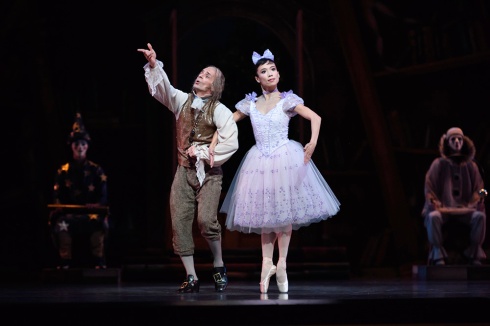March 8 San Francisco reintroduced its Pacific Northwest Ballet co-production of Coppelia, the George Balanchine-Alexandra Danilova ballet premiered at New York City Ballet in 1974. Staged by Judith Fugate, Before going into detail about designer, the Leo Delibes’ music and etc., let me say that it was memory lane. That effervescent path has been trod by anyone remembering The Ballet Russe de Monte Carlo and Danilova in Swanhilda’s shoes and Frederick Franklin as the roving-eyed Franz Some San Franciscans will remember Ruby Asquith in the Willam Christensen production. In addition, a small cadre of dancers danced in the Ballet Celeste production mounted by Merriem Lanova who had danced in the Ballet Russe de Monte Carlo version and passed it along to her young charges, touring it through the United States and Hawaii. Carolyn Carvajal was one such veteran, remembering what remained and what was new, courtesy of Mr. B.
Roberta Guidi de Bagno has given the production pastel prettiness without being goopy or stretching costumes beyond a logical take on Galacia’s folk qualities without becoming too specific. No sequins, feathers and the like. Coppelius’ attic studio is cavernous, Randall G. Chiarelli giving it just the right slightly gloomy light, neither daylight or well illumined, just as Acts I and III are suitably sunny.
Cheryl Osseola’s extensive program notes provided the audience with Coppelia’s background, E.T.A. Hoffman, the 1870 production created by Arthur Saint-Leon, Franz’ role en traverstie, ultimately Enrico Cecchetti’s revival with Franz becoming danced by a male. The lifts between Franz and Swanhilda are definitely twentieth century additions.
Carolyn remarked that the mime and plot remained untouched. The ensemble dances were different; I remember Robert Lindgren and Sonya Tyyven leading the czardas in the final act, the ensemble dances being broken up into the first and third acts and Yvonne Chouteau in Act III’s Prayer solo. Balanchine has combined them.
Tuesday saw Frances Chung as Swanhilda, Vitor Luiz as her Franz and the superb debut of Pascal Molat as Coppelius. If the program notes mention Chung’s strangeness with mime, she has moved far beyond it to a sparkling, clear ability to convey traditional query and delivery. She is one of the company’s sparkling allegro dancers; there was an almost Fonteyn-like propriety in her delivery, yet still very much Chung. Small wonder she holds an Izzie award for individual performance.
Luiz makes a believable Franz, unforced classicism, unmannered presentation and partnering impeccable. Molat’s elderly doll maker hobbles across the town square with acute accuracy of age and arthritis. His attic scene with Swanhilda’s impersonation of Coppelia was masterly; delusion and elderly excitement.
For those unfamiliar with the plot, it concerns Swanhilda, a spirited young village girl, and her boy friend Franz who also has his eye on Coppelia, a beautiful creature who is wheeled onto a balcony by her maker, Dr. Coppelius. This makes Swanhilda and Franz quarrel. In a twilight excursion, Coppelius is roughed up by Franz and friends, losing his key. Swanhilda and her friends find the key and venture into the Coppelius’ workshop at Act I’s curtain. In Act II, the girls discover the toys and the inanimate Coppelia. Coppelius returns, chasing the girls out; Swanhilda remains assuming Coppelia’s clothing. Franz, meanwhile, attempts to reach the doll via the aid of a ladder; intercepted by Coppelius, he is drugged by wine. Coppelius attempts to bring Coppelia to life using Franz’ life force, pouring over a huge book of spells. Swanhilda plays along with Coppelius, becoming more life like, only to destroy his fantasy and to flee with Franz.

Frances Chung and Pascal Molat in Balanchine’s CoppÈlia. (© Erik Tomasson)
Act III sees the dedication of the bells, announced in French language banners in Act I. Many wedding couples. Coppelius is seen, heart-broken, with his doll in his arms; Swanhilda and Franz also get married, and several celebratory dances ensue. In this production, a bevy of young students perform a charming dance, impossible for the old touring production. The Ballet Russe production provided recompense to Coppelius; here he is pushed aside all too rapidly.
The Act III divertissements featured Sasha de Sola as Dawn in a costume with golden tracery; Sofiane Sylve’s Prayer was cloaked in blue chiffon with touches of grey; four Jesterettes and finally Discord and War led by Jennifer Stahl and Hansuke Yamamoto, laden with spears, Greek-style plumed helmets and garments of black and silver metallic touches, perpetually leaping with one leg raised to waist height, moving in circles and linear patterns. The dominant note in this finale was twenty-three students in pink tutus, led by Lauren Strongin, in the Waltz of the Golden Hours, the same number commencing the January 2016 Gala. To me it took away from the earlier variations danced by de Sola and Sylve, rendering them more divertissements than sweet, evocative variations.
The Waltz is an inducement to students, and, probably, parents. Balanchine and Danilova undoubtedly had memories of similar use of students in the Imperial Ballet Academy in St. Petersburg. Used to the pared-down version, I found the yards of pink tutu a bit distracting to this French-born bon-bon. Like La Fille Mal Gardee, created in 1789 in Bordeaux by Jean Dauberval and the 1837 premiere of Giselle of Jules Perrot and Juan Corelli, these three durable ballets share French ancestry, however much layers and modifications may have ensued. Vive La France!
